
Renovation. It is a process that is approached with both excitement and trepidation. The excitement has everything to do with the results that are anticipated, while the trepidation, for many, is based on the stories told by others. I begin by telling my clients that it will cost more than they think and take longer than they think. So, we start off by planning the budget and schedule accordingly. Beyond that, I put my experience to work and hope that luck is with us, because luck is a factor.
Selecting a designer with years of experience, particularly in apartment renovations in New York City, is of special importance because that individual will best be able to anticipate many of the potential difficulties. Experience in suburban locations is almost irrelevant because there are too many city-specific issues to be dealt with which will directly affect both schedule and budget: The requirements imposed by the myriad city regulations, the co-op board, the building manager and super as well as those which govern work in a multi-family residential environment.
Anticipate Problems
From the beginning, you want to be sure to take into account the input and approval that will be necessary from the local building department, the building manager and the co-op board. Each of these groups or individuals has the authority to require changes to your plans and the approval process, especially that of the city, can be a lengthy one. It is wise, therefore, to do thorough research as to what is generally permitted and get them involved before you've spent a lot of money engineering the renovation.
The building super can often be a valuable resource in identifying potential problems. If that individual has been with the building for some time, he has probably seen any number of renovations occur and has plenty of anecdotal information about what will work and what won't do, as well as about what the problem areas in the building are.
What kinds of problems can these be? From personal experience I can say there are many, and that they cannot all possibly be anticipated because they can barely be imagined. One incident I remember should be noted, not only for its unusual nature, but because it emphasizes the need for everyone on the jobthe contractor as well as all substo have adequate insurance, something most co-op boards insist upon, and for good reason.
In this particular case, part of the renovation included a dining room, in which all I had planned was new moldings and work to the ceiling. As this work was being completed, the downstairs neighbor complained that an antique chandelier hanging directly below the dining room had been damaged. Because so little was being done in that room, and nothing that I considered heavy work, I was surprised at this contention. To check it, I went downstairs and as I watched, the chandelier bounced wildly when one of the workmen above hopped off the bottom rung of a ladder. It turned out that a main beam of the building, which ran through the center of the room, had a lot of flex in it. This was not a dangerous situation in terms of the building structure, but because the dining room table had always stood in the middle of the room, the chandelier had never before been subject to such motion. In this case, the contractor's insurance covered the damage and we continued the work with an even clearer understanding of Murphy's Law.
Electricity & Plumbing
Most problems which we encounter are much more ordinary but often much more costly to deal with. Electricity and plumbing are two major areas of concern. Plumbing is typically adequate in residential buildings. The only complication that one is likely to encounter is finding the right pipe in the maze hidden behind the walls, which can require pulling down the whole wall. In addition, your building super may require that certain shut-off valves and clean-outs be installed according to his specifications, and the city may require a change in risers, etc. to meet Universal Design Guidelines. Getting this right the first time is simply a matter of checking with the super and the city.
Electricity can be much more complicated. First, as with all work that you do to your co-op, you may find yourself upgrading a previous owner's work to meet current standards, including ADA requirements (Americans with Disabilities Act). This is often the case when it comes to the electrical wiring, switches and circuit breakers. In addition, because many co-op buildings were built years ago when power needs were far fewer, it may be necessary to increase the amount of power coming into the apartment. In fact, just ten to 15 years ago an apartment may have been rewired with 100 amp service which is considered inadequate today to handle their air conditioning, lighting and other power needs in a typical apartment. These days, 200 amp service is the norm. Upgrading the service is a relatively straight-forward process, as long as there is sufficient power coming into the building in the first place.
Because power needs have increased so dramatically in recent years, however, the adequacy of power to the building can be a real concern and one that you should have an electrician investigate. If it is necessary to bring more power into the building, and the building has not allowed for this in its capital budget, this is a cost, and a very significant one, that the owner may have to bear. Bringing additional power up to your apartment would also be your expense. If you live on the second or third floor, the cost will not be great. But if you are on the 15th floor, the cost of bringing power up could be as much as $10,000a real budget-breaker unless you are aware of it upfront.
The Value of a Renovation
In designing the renovation itself, the designer should alert the client to issues, such as the impact of the renovation on the future marketability of the co-op. You may be anxious to have a luxurious master suite, and be willing to forego the third bedroom in order to obtain it, but you must also realize that a three-bedroom apartment often has much greater value on the real estate market than a two bedroom apartment, regardless of its improvements. To address this, your designer may be able to design the renovation in such a way that the elimination of the third bedroom could be undone in a cost efficient way should it be deemed necessary. In addition, you should be aware of the impact on the Certificate of Occupancy of changing the number of rooms in an apartment. Also, if the design being proposed for your apartment is going to require variances from the co-op board, be sure those variances are obtained before an enormous amount of time has been spent finalizing the design.
Scheduling the renovation takes equal care. There are certain things that any designer, regardless of background, can warn you about. This would include allowing ample time for ordering, and re-ordering, to allow for mistakes on the part of the suppliers. You may be waiting until the tile comes in to install all the new fixtures for your bathroom and when the tile finally does arrive discover that it is cracked or the wrong color, etc. Or, it simply may not come on time. Your schedule must include enough flex to allow for such hindrances.
In a co-op building, meeting the schedule is especially vital, not just because you want the job finished, but because typically, th ffb e building will allot you a certain amount of time in which to complete the project and then charge you a daily penalty, which could be $220 per day, if the schedule is not met. Your designer, then, must not only take into account the likelihood of ordering problems, but also the limitations that will be imposed by the building. These will include limiting the hours of work, from 9:00 am to 4:00 pm, Monday through Friday, with no work to occur on numerous holidays, including many of the Jewish holidays.
Clean-Up
Finally, once all the work is finished, most people assume they can just move right in. In fact, most contracts only stipulate that the contractor is required to leave the job site broom clean. This does not mean thoroughly clean. I always recommend to my clients that they allow a couple of weeks to get a cleaning service to come and wash down every surface, remove the adhesive residue from windows, etc. Prior to move-in day, it is also wise to discuss with building management the disposal of packing materials. Will your mover be required to remove all boxes and crates? Do you have to hire a special service to get rid of these materials? Is there somewhere in the building that they can be stored while waiting for removal? Each building has its own regulations about such things and it is far better to be prepared than surprised. You should also be aware that if you will be discarding things, such as old carpeting from the apartment, arrangements must be made for it to go to a special dump site. Each category or item has its own place of disposal. It's not like the old days when everything just went away to the same dump.
Clearly, renovation is not a simple task. But if you select a good and experienced designer, and plan your budget and schedule carefully and conservatively, you will survive the project and enjoy its results. Remember, you should be hiring a designer not only to create an environment to meet your needs, but also to oversee all the details of that project. That person is being paid to get everything right, so you can relax.






Leave a Comment